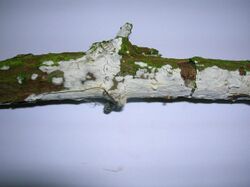Biology:Hyphodontia sambuci
| Hyphodontia sambuci | |
|---|---|

| |
| Elder whitewash on elder (Sambucus nigra) in North Ayrshire, Scotland | |
| Scientific classification | |
| Kingdom: | |
| Phylum: | |
| Class: | |
| Subclass: | |
| Order: | |
| Family: | |
| Genus: | |
| Species: | H. sambuci
|
| Binomial name | |
| Hyphodontia sambuci (Fr.) J. Erikss., (1958)
| |
| Synonyms | |
|
Hyphoderma sambuci (Pers.) Julich. | |
Hyphodontia sambuci, or elder whitewash, is a basidiomycete fungal pathogen on deadwood, especially elder.[1]
It is resupinate, forming a very thin structure which is white, pruinose (flour-like dusting) or chalky in appearance. It is inedible.[1] It also grows on dead but still hanging branches of Fraxinus, Berberis, Nothofagus, Ulmus, Populus, Hedera, Ribes, Symphoricarpos and rarely on conifers such as Cryptomeria.[2]
Ecology
As stated, H. sambuci occurs in North Europe mostly on Sambucus nigra, but there is a much bigger spectrum of substrates in warmer regions in southern areas. The variability of micromorphology increases in the tropics, but the macromorphological characteristics however always stay the same: the basidiocarp with chalky white color and often growing as aerophyte on dead branches of trees and bushes, that are still attached to the tree. H. sambuci consists of a complex of species. Similar species with capitate cystidia; thin-walled hyphae and exactly the same chalky white fruit body are H. griselinae and H. fimbriata. They can be differentiated by their spores and morphology of their basidiocarp.[2]
References
External links
- The Virtual Field Guide.
- Index Fungorum.
- USDA ARS Fungal Database.
- The National Biodiversity Network Gateway.
- World Wide distribution details
Wikidata ☰ Q1975791 entry
 |

